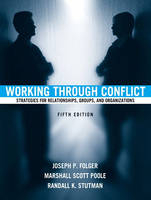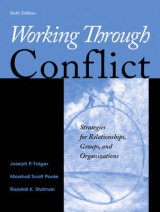
Working Through Conflict
Routledge (Verlag)
978-0-205-41490-1 (ISBN)
- Titel erscheint in neuer Auflage
- Artikel merken
Each chapter concludes with “Summary and Review” and “Conclusion.”
List of Cases.
Preface.
Introduction: Conflict Interaction.
Case I. 1A:The Women's Hotline Case.
Case I. 1B: The Women's Hotline Case (Continued).
Conflict Defined.
Arenas for Conflict.
Productive and Destructive Conflict Interaction.
Judgments About Conflict Outcomes.
More on Conflict Interaction.
Plan of the Book.
1. Communication and Conflict.
A Model of Effective Conflict Management.
Properties of Conflict Interaction.
Case 1.1: The Columnist's Brown Bag.
2. The Inner Experience of Conflict.
Perspectivism and Conflict.
The Role of Theories.
Classic and Contemporary Theories of the Inner Experience of Conflict.
The Psychodynamic Perspective.
Case 2.1: The Parking Lot Scuffle.
Verbal Aggressiveness.
Case 2.2: Psychodynamic Theory and the Parking Lot Scuffle.
Case 2.3: Verbal Aggressiveness Theory and the Parking Lot Scuffle.
Attribution Theory.
Field Theory and the Concept of Climate.
Case 2.4: Attribution Theory and the Parking Lot Scuffle.
Case 2.5: Field Theory and the Parking Lot Scuffle.
3. Theories of Conflict Interaction.
The Human Relations Perspective and Conflict Styles.
Experimental Gaming Research.
Case 3.1: Human Relations Theory and the Parking Lot Scuffle.
Case 3.2: Game Research and the Parking Lot Scuffle.
Intergroup Conflict Research.
Case 3.4: Intergroup Dynamics and the Parking Lot Scuffle.
Phase Models of Conflict.
Case 3.8: Phase Theories and the Parking Lot Scuffle.
4. Power: The Architecture of Conflict.
Power and the Emergence of Conflict.
Case 4.1A: A Raid on the Student Activity Fees and Fund.
Case 4.1B: A Raid on the Student Activity Fees Fund, Continued.
A Relational View of Power.
Case 4.2 The Eccentric Professor.
Power and Conflict Interaction.
Case 4.3: The Creativity Development Committee.
The Use of Power in Conflict Tactics.
The Balance of Power in Conflict.
Case 4.4: The Copywriters Committee.
Case 4.5: Unbalanced Intimacy.
Case 4.6: Job Resignation at the Social Service Agency.
Working with Power.
Fostering Shared Power in Group and Organizational Conflicts.
5. Face-Saving.
The Dimensions of Face.
Face-Loss.
Face-Saving: A Threat to Flexibility in Conflict Interaction.
Case 5.1: The Professor's Decision.
Case 5.2: The Outspoken Member.
Case 5.3 The Controversial Team Member.
Conflict Interaction as an Arena for Face-Saving.
Forms of Face-Saving in Conflict Interaction.
Face-Giving.
Working with Face-Saving Issues.
Case 5.4: The Productivity/Performance Report.
6. Climate and Conflict Interaction.
What is Climate? A Definition.
Case 6.1: Riverdale Halfway House.
Climate Themes.
Case 6.2: The Breakup at the Bakery.
Climate and Conflict Interaction.
Case 6.3A The Psychological Evaluation Unit.
Case 6.3B: The Psychological Evaluation Unit Continued.
Identifying Climates.
Working with Climate.
Case 6.4: The Consulting Agency.
Case 6.5: The Expanding Printing Company.
Creating Constructive Climates.
7. Doing Conflict: Styles, Strategies, and Tactics.
Conflict Styles.
Case 7.1: College Roommates.
A Procedure for Selecting Conflict Styles.
Conflict Styles and Organizational Context.
Conflict Tactics.
Styles and Tactics in Practice.
Case 7.2: The Would be Borrower.
8. Changing Conflict Dynamics.
Working Habits, Trained Incapacities and Conflict.
Some Useful Procedures for Conflict Management.
Framing and Reframing Issues in Conflict.
9. Third Party Intervention.
Property 1: Conflict Interaction is Constitute and Sustained by Moves and Countermoves in Interaction.
Case 9.1: The Food Distribution Company.
Case 9.2: The Radio Station.
Property 2: Patterns of Behavior in Conflict Tend to Perpetuate Themselves.
Third-Parties, Differentiation, and Integration.
Property 3: Conflict Interaction is Shaped by the Global Climate of the Situation.
Property 4: Conflict Interaction is Influenced by and In Turn Affects Relationships.
A Different View of Third Party Interventions.
Postscript: The Technological Future.
Case 9.3: The Negotiation Support System.
References.
Index.
List of Cases.
| Erscheint lt. Verlag | 9.9.2004 |
|---|---|
| Verlagsort | New York |
| Sprache | englisch |
| Maße | 234 x 179 mm |
| Gewicht | 552 g |
| Themenwelt | Sachbuch/Ratgeber ► Gesundheit / Leben / Psychologie ► Psychologie |
| Sozialwissenschaften ► Politik / Verwaltung ► Europäische / Internationale Politik | |
| ISBN-10 | 0-205-41490-7 / 0205414907 |
| ISBN-13 | 978-0-205-41490-1 / 9780205414901 |
| Zustand | Neuware |
| Haben Sie eine Frage zum Produkt? |
aus dem Bereich



